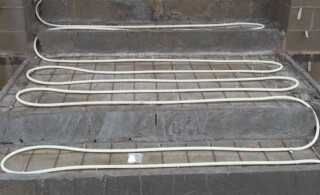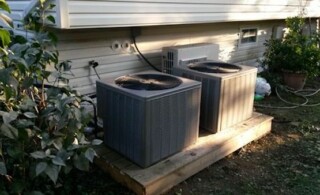
TheRabbitHolePictures/iStock / Getty Images Plus via Getty Images
Investing in a heating system for your home is no small task. Unlike the purchase of a simple air conditioning unit, heating systems can be completely different depending on your needs.
Most first-time heating system buyers are overwhelmed by the sheer options before them when they go to buy. Our guide to heat pumps, hot water boilers, and electric heat pumps will give you a thorough understanding of some of the most common options on the market for keeping your house warm.
What Is a Forced Air Furnace?
Running on gas, oil, or electricity, forced air furnaces are the most common systems available for heating your home. When you think of a furnace, this is probably what you’re picturing. The way they work is simple: A flame activates the gas, oil, or electricity inside the unit to generate warm air that is distributed throughout the home via ducts and vents.
The neat thing is that when the air cools down, the forced air furnace recycles it back into more warm air again. Depending on the medium used, forced air furnaces work a little bit differently:
- Natural gas furnaces: In order for a gas furnace to work, it needs an ignition source. These furnaces have built-in safety mechanisms that make sure the natural gas doesn’t become combustible if it escapes into the home. Gas is usually refilled to tanks in homes with relative ease by delivery services.
- Electric furnaces: Heating a home with an electric system is as simple as adjusting your thermostat to the desired temperature and waiting for the electricity to heat your home. There are no worries about refilling tanks with this option.
- Other gas furnaces: Diesel and propane are two other options available for heating your home. Diesel oil was commonly used in older homes, while propane came to unseat it and is much more affordable. Both operate the same way internally as a natural gas forced air furnace.
What Is a Hot Water Boiler?
Hot water boilers are the most popular option in colder climates. These boilers work by heating water, which warms your house from the inside out as it passes through pipes in your floors, walls, and radiators.
- Conventional boiler: This is the choice for someone looking to heat up their home very quickly. This type of boiler system is mostly paired with heated flooring. Just how effective it is all depends on the size of your water tank.
- Gas/Oil/Electric boiler: These boilers heat water using gas, oil, or electricity. Oil is the most expensive option here, with gas being squarely in the middle, and electric the cheapest option.
- Sealed system boiler: If your home is between 1,000–2,500 square feet, this is where you get bang for your buck (affordable options start at $1,500) They don’t just heat water, they also store water. This means the hot water gets delivered to every room in the house and that water can also be converted to steam for heating.
- Hydronic air handler: Another dual system option which works when water is paired over a hydronic heating coil. However, this type requires a tankless water heater.
- Wood or coal boilers: Works in the same fashion as a conventional boiler with one big benefit: should your power ever go out, a wood or coal broiler will keep working. This is worth considering if you live in an area with frequent power outages.
- Radiators: Radiators are one of the oldest heating methods around. Hot water is pushed throughout cast iron to heat it and in turn radiate that heat into the home, warming it.
What Is an Electric Heat Pump?
The biggest difference between electric heat pumps and furnaces or boilers is it is a heating system that doesn’t rely on an ignition point. Instead, it pulls external heat into the home and transforms it into gas. That gas heats the coil responsible for moving hot air into the home. They cost between $260 and $850 per year.
- Air source pumps: This one doesn’t just heat your home, it also works as an air conditioner during the warmer months. That said, it is better for warmer climates as it requires a lot more energy when the weather is below freezing.
- Geothermal pumps: Air source pumps pull heat from the air, but geothermal pumps take heat from the ground, which is a more constant source. That said, it is also more expensive than an air source pump for that reason.
- Ductless pumps: If you live in a home with no ducts, including most historic homes, ductless pumps are the option for you. The pump works using a unit which is connected to your home and directs in hot or cool air accordingly.
How Each Type Compares
Before making your final decision, here are some things to consider.
Most Value: Furnaces
You will spend between $820 and $1,550 to heat your home annually using any type of furnace. If you live in a place where heating your home is essential, this is a good value for money. If you live in a warmer climate you can most likely do just fine with a pump system and spend between $260 and $850 annually.
Most Green: Sealed-System Boiler
Because it heats the home and heats the water, and because it can be easily installed at home, the carbon footprint on this system makes it a no-brainer for the homeowner looking to make the home of their dreams a green one, too.
Most DIY Friendly: None!
Installing a new heating system is an extensive and serious job that requires training. You can hire someone to install a heating system for between $850 and $5,500. Over time, you can familiarize yourself enough with your system to learn to handle maintenance, but for installation stick with the pros.
Most Durable/Longest Lasting: Boilers
Compared to other heating systems, boilers are the titans of longevity. If you install a boil you shouldn’t have to worry about replacing it for between 15 and 30 years.
Find a Pro for Your Furnace Replacement Radiant Floor Heating – How it Works & Benefits
Radiant Floor Heating – How it Works & Benefits  Central HVAC Maintenance – Tips & Advice
Central HVAC Maintenance – Tips & Advice  Increasing Attic Ventilation with Soffit Vents
Increasing Attic Ventilation with Soffit Vents  Green Air Conditioning
Green Air Conditioning  Whole House Fans
Whole House Fans 

I have extensive experience in helping home owners cut their utility costs in half, for their existing homes. I have also performed many consulting designs for homes to be built.
It would be too lengthy here to cover all my comments,, but I will give you a few bench marks.
My non improved neighbor’s houses cost 10 to 12 cents per sq ft per month on annual basis for total ele,, gas cost.
Example, a 3000 sq ft house is averaging $300 to $360 per month total utility cost, not including water/sewer.
My customers who have followed my directions of improvements, that they did them selves,, average about 6 cents.
My house, all improvements done post construction, averages 5 cents.
My daughter’s house,, no gas available so all electric (heat pumps, clothes dryer,, water heating, which would be cheaper if nat gas available),
averages 3 cents. I designed and built her 3800 sq ft (conditioned space) myself,, and incorporated best practices for each portion of construction. From foam board insulated foundation walls to radiant barrier attic. She can operate the house (a/c in summer, heat in winter, hot water etc) with a 6,000 watt gas generator when experiencing a power outage. You good article mentions the terrible duct loss most houses experience. In my experience, I have seen very few well built houses. If you consider just metal duct work, one system for 1500 sq ft, easily 120 linear feet of ducts,,each joint every 4′, 99% air tight at each joint, air leakage alone is 30%. (120 ‘÷4=30 joints, times 1% loss per joint/side seam).
So, builder puts in 3 ton system, when 2 would be fine. Insulate the system,, including the boots,trunks, returns, seal around all supply grilles, tape on air handlers, aluminum tape every seam, keep duct work out of attic or crawl space, seal around all air filter returns, insulate all water lines, build rest of house with attention to all details, and and 3 cents a sq ft is quite doable. For new house construction, I review the owner’s plans in detail, (i do not change the design unless obvious error,, and i discuss areas of improvement with the owner), to provide best practice notes on each phase of construction, strive for lowest operating cost, for healthiest air, lowest maintenance, comfortable air temps etc.( I never suggest changing a thermostat temp setting from what customer wants). I do recommend air handlers and all duct work be installed within the conditioned envelope of the the house, ie,mechanical room,, closet, duct work between floors, basement location.
I charge $1 per sq ft of house for this review. That provides about a 50 to 75% return on investment in first full year, and is gravy after that.
It is the responsibility of the owner to insist that his contractors follow the correct practices. I have found no correlation between the selling price of a house and the quality of construction. The same HVAC dealer who installs a system in a $300,000 house, performs the same level of attention in a $3,000,000 house.
As one “high end custom builder” once proclaimed to me, “Give them the size they want, show the little lady a fancy kitchen with a granite island, give the dude a big bbq deck or a man cave, and the rest of the house can be crap”. “I don’t pay their utility bills, and cut every corner i can to make a buck”. I examined one of his “high end ” houses. An upstairs shower stall was open in the back to a side attic. Just studs, no wall, no insulation, just the exposed shower shell.
There you have my take on your excellent article that should be helpful.
Paul Hayden